Continuous improvement is a way of life for any business and is accepted as a standard approach in improving quality, productivity and processes. At the core of continuous improvement is defining root causes, planning and executing preventative action to eliminate the potential issue, and deploying technology and practices that minimize the impact of any issue or hazard. This approach to continuous improvement can be extended to electrical safety and is sorely needed.
Ask any executive, operations manager or health and safety professional, the first priority in dealing with a potentially negative issue is to prevent the issue from occurring whenever possible, and the second priority is to minimize the impact should the negative event occur. Yet we continue to fail to take this approach when discussing arc flash and electrical safety and rely on communication and protection rather than prevention and minimization. Consultants, facility managers, maintenance personnel who downloaded an editorial on electrical safety, written by I-Gard and offered via EC&M, were asked the following questions:
1. What in your opinion is the leading cause of arc flash incidences?
- 3 phase faults
- Ground faults
- In-line faults
- Phase to phase faults
2. What is the best means to minimize the arc flash hazard?
- High Resistance Grounding
- Optical Detection
- Labels and warnings
- PPE
We took the answers and studied the following results:
The results are a cause for concern on several levels. Almost 60% of respondents indicated that in their opinion options that protect against the impact of the hazard or warn about a hazard are the best means of minimizing the impact. PPE certainly protects the individual in the event of an arc flash, but in no means does it reduce the likelihood or impact of the hazard.
The 40% that chose a technology-based approach at least opted for a proactive measure, but the measure chosen is not applicable in all cases.
For example, high resistance grounding (HRG) technology does not protect against phase-to-phase or 3-phase faults, and optical detection does not protect against ground faults.
It is clear that if we are to make a difference in electrical safety, then awareness of the issue, the root cause of the hazard, and options for mitigation must be communicated and understood effectively.
Empirical data suggests that there are generally three types of faults in industrial power systems:
- Ground Faults accounts for 98% of these failures;
- Phase-to-phase faults are less than 1.5% of the total, and are usually the result of line-to-ground faults that aren’t cleared;
- Three-phase faults are less than 0.5% of all faults. Most of these are man-made; in other words, they are accidents caused by improper operating procedures
A leading U.S. based insurance company notes that over a 7-year period their clients reported 228 losses that were attributed to ground faults resulting in payments of $180 million. There were 72 occurrences in the commercial sector, hotels, universities, hospitals and shopping malls at an average cost of $830,000 each, and 156 occurrences in manufacturing locations with an average cost of $769,000 per occurrence.
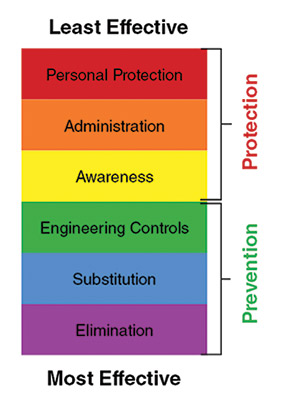
Figure 1. Risk Control Hierarchy

Figure 2. Questionnaire results
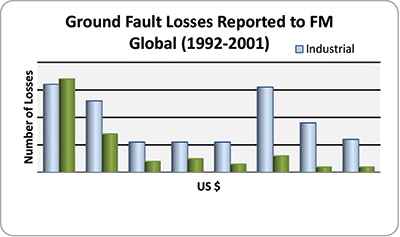
Figure 3. Ground-fault losses
An electrical arc fault, which is an intermittent failure between phases or phase-to-ground, is a discontinuous current that alternately strikes, is extinguished, and restrikes again. The arc fault has a lower occurrence rate than a ground fault, but the potential damage is significantly higher. According to statistics compiled by CapSchell Inc, a Chicago-based research and consulting firm that specializes in preventing workplace injuries and deaths, there are five to ten arc-flash explosions that occur in electric equipment every day in USA, resulting in medical treatment.
Root Cause Analysis
At the very core of the ground fault issue is one simple fact — the decision on which type of grounding system to employ directly impacts the frequency and severity of the arc flash hazard. The incorrect choice in terms of grounding system is the root cause.
When designing or specifying a grounding system for an industrial or commercial operation, there are three basic choices: ungrounded, solidly grounded, or resistance grounded. The most common practice in North America is solidly grounded, and this is the root cause of the arc flash hazard.
When deciding which type of grounding system to specify or operate, the decision should come down to two related factors — electrical reliability and electrical safety. We want our process to run free from interruptions as much as possible, and we want to operate in a safe manner.
Absent ground faults, any of the three options are reliable and safe, but ground faults are a reality in any electrical system and so the question becomes how reliable and safe is my grounding choice when a ground fault occurs.
To answer this important question we can employ the Deming Circle.
PLAN – a safe and reliable electrical distribution system even when there is no ground fault.
DO – choose one of the three standard grounding schemes.
CHECK – what can we learn from industry practices, experts and arc flash incidents.
ACT – finalize the choice of grounding system based on review of information.
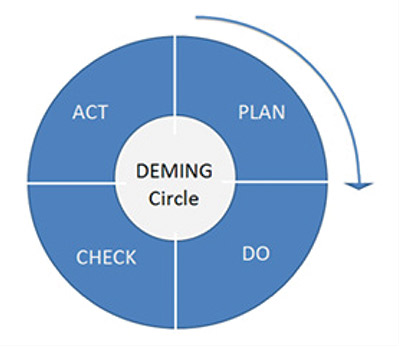
Figure 4. Deming Circle
Grounding System Review
The Ungrounded System was often chosen for industries where process continuity was vital as the system would continue to operate under a single ground fault condition. The issue, however, was the inability to quickly or effectively locate the ground fault and the damage that operating with an active fault could create.
During a ground fault on an ungrounded system, the arcing nature “charges” the system capacitance. When the arc extinguishes (possibly due to AC waveform – zero crossover), the charged system cannot dissipate the charge, so it holds it. When arc re-strikes more charge is added to the system. This continues until the insulation breaks down at the weakest point in the system. The concern over the safety aspect of ungrounded systems, when experiencing a ground fault, is noted in IEEE 242-1986 Recommended Practice for Protection and Coordination of Industrial and Commercial Power Systems. Clause 7.2.5 has a number of notes on ungrounded systems:
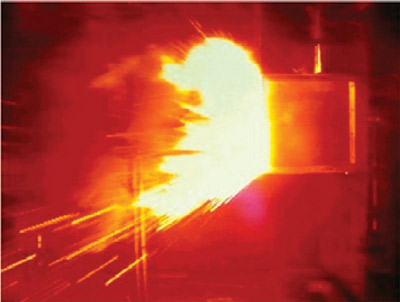
Figure 5. Arc flash
“A second ground fault occurring before the first fault is cleared will result in a phase-to-ground-to-phase fault, usually arcing, with current magnitude large enough to do damage, but sometimes too small to activate overcurrent devices in time to prevent or minimize damage.”
“Ungrounded systems offer no advantage over high-resistance grounded systems in terms of continuity of service and have the disadvantages of transient over-voltages, locating the first fault and burn-downs from a second ground fault. For these reasons, they are being used less frequently today than high-resistance grounded systems, and existing ungrounded systems are often converted to high-resistance grounded systems by resistance grounding the neutral.”
“Once the system is high-resistance grounded, over-voltages are reduced and modern highly sensitive ground-fault protective equipment can identify the faulted feeder on first fault and trip one or both feeders on second fault before an arcing burn-down does serious damage.”
Contained within this accepted industry guideline is the recommendation to convert the dangerous ungrounded system to the safer high resistance grounding system; yet some 60,000 industrial facilities in North America continue to operate their facility in this risky manner.
Solidly Grounded is the most common choice for electrical distribution in North America. Under normal operating conditions, this is a safe and acceptable option. However, reliability and safety are both impacted when the system is subject to a ground fault. A ground fault of sufficient magnitude will trip the overcurrent protection and isolate a process. For this reason, most relays are set to the maximum, and this is when safety and reliability are impacted. An arcing fault may not be of sufficient magnitude to be detected by and to trip the overcurrent device until the arc fully develops and it becomes destructive and possible deadly.
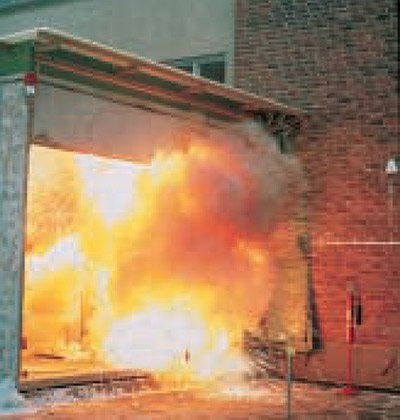
Figure 6. Arc flash
In the IEEE 141-1993, Recommended Practice for Electrical Power Distribution for Industrial Plants section 7.2.4, it states, “The solidly grounded system has the highest probability of escalating into a phase-to-phase or three-phase arcing fault, particularly for the 480 and 600V systems. A safety hazard exists for solidly grounded systems from the severe flash, arc burning, and blast hazard from any phase-to-ground fault.”
To put things into perspective, there was a recent electrical fire at a recreational facility that resulted in consequential damages of $400,000, mostly in business interruption costs. As the forensic engineers and insurance investigators conducted their review, the focus was who and what were to blame for the losses.
The engineers and insurance representatives for all parties reviewed all aspects of the electrical equipment that was specified and installed, including settings and commissioning reports. They questioned the integrity of the electrical switchgear, the protection relays and components specified in the electrical system, the installation practices of the electrical contractor, the maintenance schedule and its effectiveness, etc.
The focus was not on whether the electrical system specified or used was correct or safe but simply who in the supply chain of electrical equipment and services would pay for the damages. During the course of the investigation, a simple question was raised: Was the grounding method chosen by the consulting engineer and the facility owner or by the operator? Was the choice of grounding system the root cause of the failure?
High Resistance Grounding of low-voltage power distribution systems in North America became more prevalent in the early 1970s for continuous process industries who wished to maintain the continuity benefits of operating an ungrounded distribution system but wanted to eliminate the safety hazard of transient over-voltages and burn downs due to a second ground fault. As a technology HRG is applied to industries as diverse as food processing, mining, petrochemical and even commercial installations such as airports, data centers, etc., to enhance the reliability and uptime of power distribution equipment. It proves effective in significantly reducing the frequency and severity of arc flash accidents.
With the correct application of HRG limiting the fault current to between 5 amps and 10 amps, there is insufficient fault energy for the arc to re-strike and it self-extinguishes, causing the hazard frequency to be reduced. At the same time, the process is allowed to continue to operate with a single ground fault that is limited and controlled to a safe level.
The choice of HRG directly impacts the arc flash hazard both in frequency and impact. The technology is applied on any electrical distribution system up to 5 kV and in some cases 15 kV, where there are no line-to-neutral loads to be serviced. The effective deployment of HRG technology will reduce the number of arc flash incidences 90% or more.
Section 7.2.2 of the IEEE Red Book states that when using high resistance grounding, “There is no arc flash hazard as there is with solidly grounded systems, since the fault current is limited to approximately 5 A.” The Red Book is referring here to phase-to-ground faults.
I once read a statement in a competitor’s advertisement that HRG should be considered when reliability is important and there is concern about arc flash. I cannot think of any application or industry where reliability is not important and where arc flash is not a concern.
As noted earlier, HRG does not offer protection or reduction in phase-to-phase or 3-phase faults that can result in arcing. For these issues, alternative technology must be considered. Technology such as optical arc detection (which is the quickest) and arc pressure sensing (which is not prone to nuisance tripping and is, therefore, the most reliable) protect against the arc flash and lower the incident energy to safer levels. While there is a place for labels, warning signs and PPE as protection and awareness these options should be implemented only after steps are taken to reduce the frequency and impact of a hazard.
It is clear and irrefutable that the greatest likelihood of arc flash hazards occurs when employing a solidly grounded or ungrounded system. HRG offers a viable alternative, one that lowers the frequency and impact of the arc flash and one that ensures operational reliability even when there is an active ground fault. It is time we addressed the root cause of the arc flash hazard. It is time we got serious about electrical safety. It is time that high resistance grounding be considered a viable option.












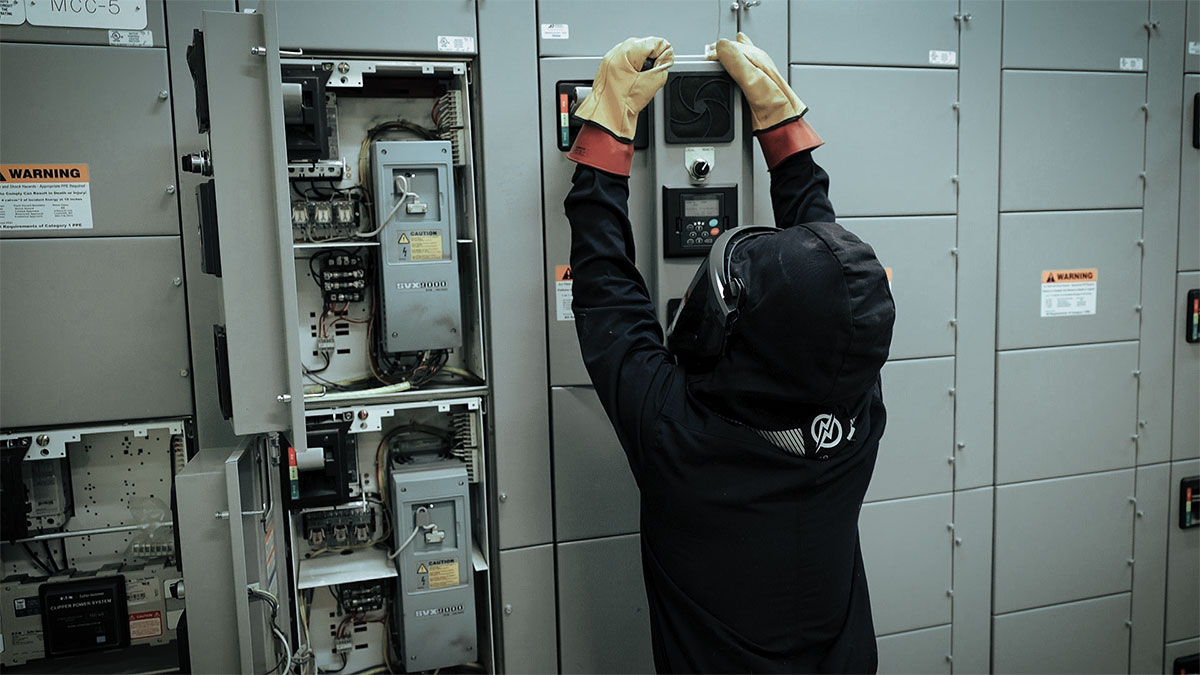


Find Us on Socials